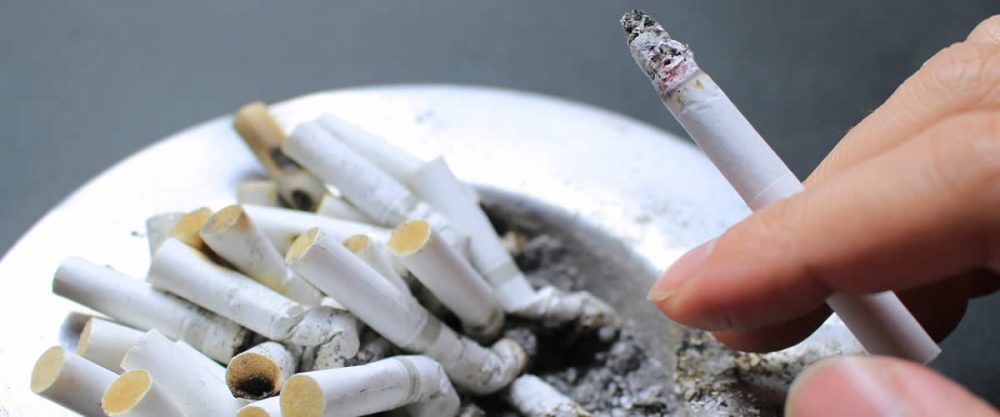Blog Posts
What Is Third-Hand Smoke and How Does Vamoose! Reduce Exposure
For several years, second-hand smoke was the hot topic of discussions as scientists had found it contributed to a high number of minor and major illnesses. Many are unaware of the effect that third-hand smoke has and how it can be more dangerous than second-hand.
What Is Third-Hand Smoke?
Dr. J. Taylor Hays of the Mayo Clinic describes third-hand smoke and why the public should be more aware of it. According to Dr. Hays, this type of smoke is caused by the nicotine, chemicals and other dangerous residual materials left after smoking. Innocent bystanders touch surfaces where this residue is left behind without realizing it. Children are especially susceptible as well as infants. When people touch these chemicals and then immediately touch their eyes, wipe their faces, eat food, etc., they are ingesting and introducing harmful materials into the body.
How Does Third-hand Smoke Affect Me?
Although research is still new, experts such as those from the Cleveland Clinic have found that third-hand smoke presents five specific dangers. And, due to the chemical nature of the residue, the threat of contracting tobacco-related illnesses increases because the residue is difficult to remove. It will also remain on a surface for a prolonged period of time if not cleaned properly.
Cancer
Among the first dangers of third-hand smoke is cancer. As scientists explore the effects of smoking on lung cancer patients, they are becoming increasingly aware of non-smoking related lung cancers. As of late, they have come to believe that many of these patients are second, or more likely, third-hand smoking victims.
Formation of Carcinogens
When nitrous acid comes into contact with the nicotine and toxic chemicals from smoking, carcinogens form. This is a concern because carcinogens are one of the leading culprit compounds that cause cancer.
Damaging DNA
As with exposure to any dangerous foreign chemical to the body, exposure to toxic residue left by smoking can alter DNA. Scientists have come to find that because third-hand smoking puts you in direct contact with dangerous chemicals, and can be more aggressive in attacking the DNA and any healthy cells within the body.
Who Is Most at Risk?
While second-hand smoke is a risk to everyone who comes into contact with it, third-hand smoke has been discovered to be especially threatening to children. Those who have children or are aware of their behavior understand that children (especially very young children) tend to put things in their mouths. This includes their hands as much as other objects while adults tend not to have these habits. For this reason, children can be at more of a risk.
The second party who seems to suffer most are house pets and animals. Similar to children, but even more prone to ingest chemicals, are pets. Whether it be a cat, dog, reptile, or other house-pet, these often overlooked members of the family are also at high risk of ingesting harmful materials into their bodies. Many pets sleep on the same surfaces where the residue settles and play with toys that contaminated. Also, someone who has come into contact with third-hand smoke can easily touch or handle pets and share dangerous chemicals.
What Surfaces Are at Risk
Surfaces that pose the most significant threats include plush toys, blankets, carpets, walls, cabinets, and furniture. Because of the strength of the residue, it is easy to detect third-hand smoke, which will often time leave a yellow or brownish like tint, be very sticky, and also emit a soured-smoke smell. The residue left behind can even adhere to glass and potentially to insulation. In outside areas, the residue has been found on plants, their containers, and flowers. This residue is even more alarming for people who have pets that have houses or toys outside, which can just as easily be contaminated.
How to Prevent Third-Hand Smoke
One of the most effective ways to safe-guard against any potential effects of third-hand smoke is for those who are smoking to do so outside. They should also remain a safe distance away from any high-traffic places, and areas in which surfaces and furniture are regularly used. Because the chemicals can easily spread distances of 25 feet or more, smokers should consider being a minimum of 50 feet away and make sure to wash their hands immediately after smoking. Clothes should also be washed individually from other laundry to prevent the spread of hard-to-remove chemicals from the fabrics.
How to Remove Third-Hand Smoke from Surfaces
Researchers have found that what makes third-hand smoke more dangerous than second is that it is incredibly difficult to remove from surfaces, especially from fabrics and upholstery. An article published by researchers stated that these chemicals not only adhere to surfaces, but in the case of fabrics and upholsteries, they sink down and semi-settle. Furthermore, they are released back into the air when the covered surface is used and can cause repeated risk until the surface is appropriately cleaned.
There are several steps to efficiently and adequately removing third-hand smoke from surfaces. There is no way to prevent third-hand smoke except to consider a smoke-free environment.
Step One: Hot Water and Detergent
First, the area should be cleaned with very hot water and a neutral detergent. The water will need to be changed frequently to prevent rubbing more of the residue on the newly cleaned surfaces rather than actually cleaning them.
Those who are cleaning should make sure to wear gloves and protective face masks. Any clothes that are worn during cleaning, including the gloves and masks themselves, and any rags used should be disposed of immediately after use.
Step Two: Second Cleaning with Chemicals
After the area has been sufficiently cleaned and left to dry, doctors recommend going back and cleaning a second time with an approved chemical that will further remove residue and kill any potentially toxic or hazardous chemicals that have been left behind. Products such as Vamoose! Will get deep down into fabrics and upholsteries. Other chemical removers that frequent the tobacco and nicotine removal market are Lysol, Clorox, and Febreeze.
Step Three: Replacing Materials
Not everything will be salvageable. After the areas have been cleaned thoroughly through steps one and two, often times you will have to consider repainting walls, replacing covers and curtains, cleaning out ducts and replacing filters, and much more. Remember that this residue travels and settles, so to ensure the most effective clean possible, don’t be afraid to replace and clean even in the smallest, most hidden places. In fact, doctors suggest that if it can be easily replaced (such as blinds, curtains, or small toys), it is better to do so.
Top Smoke Odor Remover & Cleaner: Vamoose!
There are several different chemical cleaners on the market. However, none of these are designed specifically to eliminate smoke odors the way Vamoose! does. This product has been specially designed to target cigarette and tobacco odors and residue, removing them permanently. How Vamoose! works is that it penetrates deep into surfaces and materials actually seeking out the tar and nicotine, dissolving both and then turning them into non-harmful gaseous molecules. These then disintegrate without causing further damage to fabrics and surfaces.
Products come in industrial sizes all the way down to handheld spray bottles with formulas that are patented to tackle different depths of tobacco and nicotine damage. The company also has several different instructional and usage guides that target specific areas for the best clean. Vamoose! has been proven to permanently remove tobacco and nicotine third-hand smoke from homes, vehicles, and apartments among much more.
What’s more, each product comes with a 30-day Money Back Guarantee. And, customer service is always a phone call away to help with questions or concerns about the product and its use. Vamoose! is passionate about removing harmful smoke-related residues and will gladly assist with advice and suggestions.
Prolonged Third-hand Smoke Damage
Clinic researchers have come to agree that long-term exposure to third-hand smoke will only result in permanent damage. The residue will stay on a surface or in a fabric indefinitely only to attract more residue and other chemicals in the process. Layering these residues has a compounding effect that makes it harder to remove with each layer.
For humans and pets, prolonged exposure can have the same effect as the actual smokers themselves but to more areas of the body where the residue comes into contact. This is especially true for young children who, in the past, have gone years living in an environment with daily exposure.
To prevent harm to your loved ones and belongings, using a product like Vamoose! can be used repeatedly to ensure the contamination is cleaned up for good.


Comments are closed.